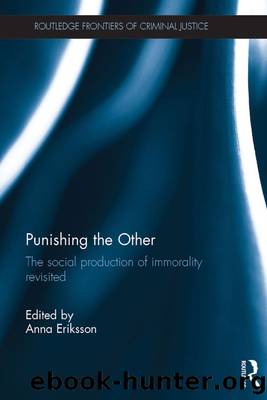Punishing the Other by Anna Eriksson

Author:Anna Eriksson [Eriksson, Anna]
Language: eng
Format: epub
ISBN: 9781138776944
Barnesnoble:
Publisher: Taylor & Francis
Published: 2015-09-17T00:00:00+00:00
For some time, several US academics (see, for example, Eagly 2010; Chacón 2012) have been alerting to the steep increase in prosecution rates for immigration crimes, particularly illegal entry and re-entry. From 1997 to 2009, immigration prosecutions soared more than tenfold (Sklansky 2012: 166), while plateauing since 2011 due to a decline in apprehensions on the southern US border. The exponential increase and patterns of prosecution led to speculation that the criminal justice system is predominantly called forth to perform the work of immigration law, namely immigration screening (Eagly 2010: 1349, 2013). In Europe, most countries criminalize immigration contraventions although the rate of enforcement of these offences remains relatively low and is in decline.
In combination, the operation of âcitizenâ and ânon-citizenâ criminal law contributes to the high proportion of non-citizens behind bars in countries across the Atlantic. In 2014, foreign-born inmates represented 25 per cent of the US federal prison population.12 While there are important variations across jurisdictions, foreigners are consistently over-represented in the prison population of Western European countries, with a share of the prison population averaging 21 per cent (Aebi and Delgrande 2010: Table 3). Arguably, however, focusing on criminalization strictu sensu leads to a distorted picture of the extent of the punitive management of immigration. Indeed, due to their status, non-citizens in breach of the law are likely to be handled outside the criminal justice institutions.
Non-criminal punitive law
Criminal lawyers often describe punishment as the most intrusive form of state coercion. Because of the stigma associated with it and the severity of the resulting sanction, particularly if it entails internment, a criminal conviction is prefaced by a plethora of additional protections and safeguards. In recent years the creation of an array of civil preventive orders, which authorize the imposition of coercive measures outside the criminal proceeding, has undermined the basic tenet of liberal criminal law (Ashworth and Zedner 2010). Immigration law sanctions a range of quasi-criminal measures, like administrative detention and removal. Although formally they stand outside the criminal law and are regulatory in nature, they resemble past and current forms of punishment and are frequently deployed to attain ends germane to punishment: deterrence, incapacitation and retribution (Bosworth 2011, 2012, 2013).
Since the ultimate penalty against foreigners in breach is territorial ejection, unsurprisingly prosecution and punishment are often adjudged ill suited to deal with them. In the UK, there is a longstanding practice of pursuing administrative action (removal), instead of prosecution, against foreigners suspected of having committed offences while in the country. This practice is largely underpinned by a pragmatic rationale, since removal is considered a less cumbersome and more (cost) effective means to rid the country of both petty offenders and terrorism suspects (Aliverti 2013a: 62; Ashworth and Zedner 2014: 244). Although this practice is highly inconsistent and varies according to the force in charge, in recent years the use of immigration-type measures to address crime-related problems has become increasingly institutionalized.
In September 2012, the Metropolitan Police and the Border Force launched Operation Nexus in London. The scheme has
Download
This site does not store any files on its server. We only index and link to content provided by other sites. Please contact the content providers to delete copyright contents if any and email us, we'll remove relevant links or contents immediately.
Chaco's Northern Prodigies : Salmon, Aztec, and the Ascendancy of the Middle San Juan Region after AD 1100 by Paul F. Reed(355)
Law Enforcement Interpersonal Communication and Conflict Management by Brian Douglas Fitch(348)
Digital International Relations by Unknown(347)
Critical Perspectives on Human Security : Rethinking Emancipation and Power in International Relations by David Chandler; Nik Hynek(329)
Skilled interpersonal communication: Research, theory and practice, Fifth edition by Owen Hargie(327)
The Enduring Color Line in U.S. Athletics by Krystal Beamon Chris M. Messer(325)
Evidence-Based Policy Making in Labor Economics by Hamermesh Daniel S.;Nottmeyer Olga K.;Nottmeyer Olga;King Sarah;King Sarah;King Sarah;(298)
EPSO CAST Political affairs EU policies: How to succeed in the selection procedure by Franco Reverte José María(291)
Writing Public Policy - A Practical Guide to Communicating in the Policy Making Process by Catherine F. Smith(272)
Criminological Theory in Context by John Martyn Chamberlain(270)
Tibeton Yoga Its Secret Doc by Evans-Wentz(267)
Rothschild and Early Jewish Colonization in Palestine (Geographical Perspectives on the Human Past) by Ran Aaronsohn(266)
Threshold Concepts in Women's and Gender Studies by Christie Launius Holly Hassel(265)
Positive Psychology and Spirituality in Counselling and Psychotherapy (Conflict, Ethics, and Spirituality, 12) by unknow(261)
Social Problems, Social Issues, Social Science by James Wright(260)
Play in child development and psychotherapy: toward empirically supported practice by Sandra W. Russ(254)
Cognitive Development in Infancy and Childhood (Elements in Child Development) by Mary Gauvain(253)
Latin American Politics and Society by Gerardo L. Munck & Juan Pablo Luna(224)
What Makes a Social Crisis?: The Societalization of Social Problems by Jeffrey C. Alexander(220)
